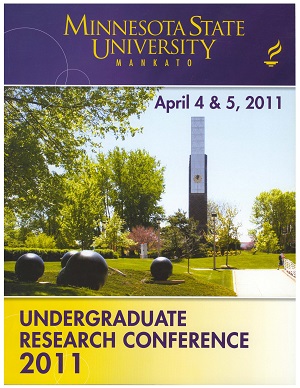Urinary Incontinence among College Athletes
Location
CSU 253/4/5
Start Date
4-4-2011 9:00 AM
End Date
4-4-2011 10:30 AM
Student's Major
Psychology
Student's College
Social and Behavioral Sciences
Mentor's Name
Britta Fiksdal
Mentor's Department
Psychology
Mentor's College
Social and Behavioral Sciences
Second Mentor's Name
Daniel Houlihan
Second Mentor's Department
Psychology
Second Mentor's College
Social and Behavioral Sciences
Description
Urinary incontinence is the involuntary loss of urine which results in social discomfort and poor hygiene. The causes include coughing, sneezing, physical activity, and sudden body movements (Dockter, Kolstad, Martin, & Schiwal). This study looks at the problem amongst athletes who were asked questions regarding the sport they participate in and their health. The population consists of both males and females ranging from ages 18 to 29 years old and there was a variety of ethnicities who participated. The purpose of the study was to see whether or not athletes are more prone to experiencing urinary incontinence compared to non-athletes and also if athletes are more willing to report urinary incontinence. Information about the sport the individual is in, how often they work out or exercise, whether or not they are sexually active, and whether or not they have experienced urinary incontinence or if anyone they know has experienced urinary incontinence and the frequency was collected through the survey. The data has been gathered and is currently being analyzed.
Urinary Incontinence among College Athletes
CSU 253/4/5
Urinary incontinence is the involuntary loss of urine which results in social discomfort and poor hygiene. The causes include coughing, sneezing, physical activity, and sudden body movements (Dockter, Kolstad, Martin, & Schiwal). This study looks at the problem amongst athletes who were asked questions regarding the sport they participate in and their health. The population consists of both males and females ranging from ages 18 to 29 years old and there was a variety of ethnicities who participated. The purpose of the study was to see whether or not athletes are more prone to experiencing urinary incontinence compared to non-athletes and also if athletes are more willing to report urinary incontinence. Information about the sport the individual is in, how often they work out or exercise, whether or not they are sexually active, and whether or not they have experienced urinary incontinence or if anyone they know has experienced urinary incontinence and the frequency was collected through the survey. The data has been gathered and is currently being analyzed.
Recommended Citation
Marsh, Sarah and Brianna McLaughlin. "Urinary Incontinence among College Athletes." Undergraduate Research Symposium, Mankato, MN, April 4, 2011.
https://cornerstone.lib.mnsu.edu/urs/2011/poster-session-A/17




